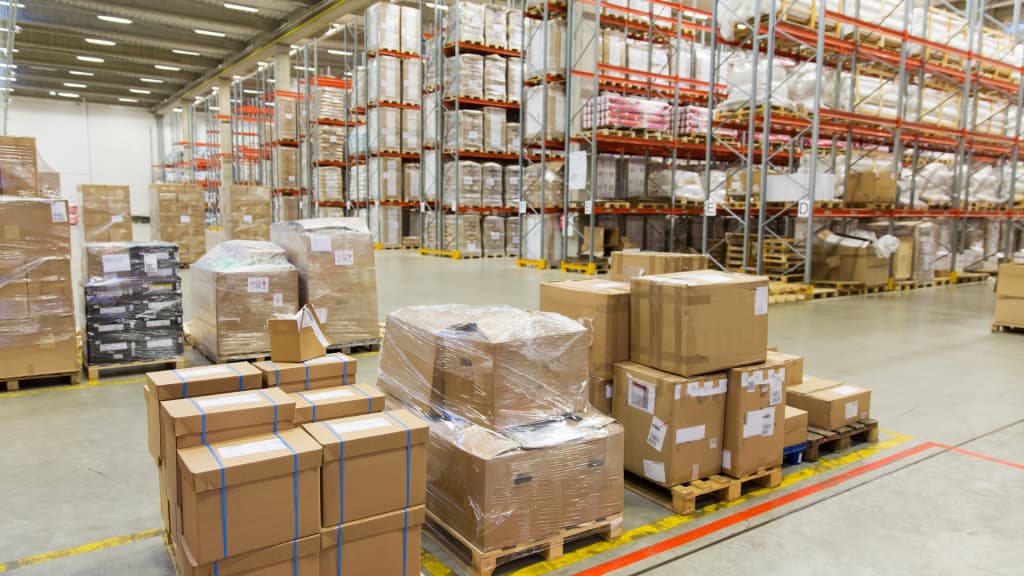What Is A Dry Van Truck?
If you’re in the shipping industry, you’ve likely heard the term ‘dry van truck’ tossed around. But what is a dry van truck? Also known as a dryvan, a dry van truck is a type of enclosed trailer used to transport non-temperature-sensitive cargo and is one of the most common types of trucks on the road today. In this blog post, we’ll take a look at what dry van trucking is, how it works, and how it is used in the transportation industry. We’ll also discuss the advantages and disadvantages of dry vans, so you can make the best decisions for your shipping needs.
Why Are They Called Dry Van Trucks?

Dry vans are large, enclosed trailers, typically ranging from 48 to 53 feet in length. The 53 foot trailer, or 53′ dry van, is particularly common in the industry. These containers represent the usual truck you will most likely see on the road. Dry van trailers are ‘dry’ because they ship freight without requiring temperature or climate control. Because these dry van trailers are fully enclosed and protected, dry van freight shipping is the best way to protect cargo from external influences like bad weather or temperature fluctuations.
When should you use dry van shipping?
A dry van, also known as a box truck, straight truck, or enclosed trailer, is a type of trailer used for transporting goods. These trailers are designed to be enclosed and can typically carry anything from building materials to furniture. Dry van trailers are an ideal choice for those needing secure and reliable transportation services. Dry van shipping is also an ideal solution for transporting larger items such as pallets or appliances. When selecting a dry van trailer, several features should be taken into consideration, such as size, weight capacity, and ease of loading.
Dry van trailers come in various sizes, depending on the needs of the customer. For example, a 53′ dry van may be able to fit several large items while smaller vehicles are better suited for smaller loads. Additionally, the weight capacity of the vehicle must be taken into account when selecting a dry van trailer. This will determine how much cargo the trailer can safely transport. Lastly, it is important to consider how easy it will be to load items into the van. Many dry van trailers come with lift gates or ramps that make loading and unloading much easier and faster.
How is a dry van trailer different from other types of trailers?

A dry van trailer is a type of enclosed trailer used to transport goods that need to stay protected from the elements. Unlike other types of trailers, such as flatbed trailers or refrigerated trailers, dry vans are completely enclosed to keep the contents safe and secure during transit. Dry van trailers are most commonly used for transporting building materials, such as lumber, drywall, and insulation.
What Is A Straight Truck In Shipping?
In contrast to dry van trailers, straight trucks, or box trucks, integrate the cargo area with the cab on a single chassis. This design offers greater maneuverability, making straight trucks ideal for urban deliveries or shorter routes. While dry vans are detached and hauled by a semi-truck, straight trucks are one continuous vehicle, which simplifies navigation in tight city spaces and is perfect for ‘last mile’ delivery services. Their compact size, however, limits the volume and weight of cargo they can carry compared to the larger dry van trailers, which are better suited for bulkier and heavier loads.
The biggest difference between a dry van and other trailers is that the walls and roof of the dry van offer an extra layer of cargo protection against extreme temperatures, moisture, and other environmental factors. This makes them ideal for transporting items that are sensitive to temperature and humidity fluctuations. In addition, dry van trailers can also be equipped with cargo securement systems to further protect items from shifting or falling out during transport.
Should You Use A Dry Van Or Van Truck For Shipping?
Van trucks are usually used for local trips and short-haul shipping, whereas dry vans are better suited for long-distance hauling. The enclosed structure of a dry van also makes them well-suited for shipments that require additional security. With their tight-fitting panels, they offer added protection against tampering and theft. Furthermore, since the dry van body is closed off, there is less airflow compared to an open-bed truck which increases fuel efficiency. As a result, dry van trailers are often used when making extended trips across state lines or even overseas.
What are the benefits of using a dry van trailer?
Dry van trailers offer many advantages for businesses that need to transport goods, building materials, and more. The most significant advantage of using dry van trailers is that they are extremely versatile and can be used for a variety of cargo. This makes them ideal for companies looking for a reliable and cost-effective way to transport items.
Dry Van Trucks Are Durable
Another major benefit of using dry vans is their durability. These trailers are built with sturdy metal frames and walls, which means they can handle heavier cargo. They also provide superior protection against weather damage and theft, allowing your shipment to arrive safely at its destination. The interior lining of dry vans adds an extra layer of protection for sensitive goods.
Dry Van Trucks Are Cost-Effective For Shipping
In addition to being incredibly durable, dry van trucks are also cost-effective. The trailers are designed with lightweight materials that make them easy to maneuver. This reduces fuel costs, making it much cheaper to transport your cargo. Some manufacturers, like Utility, have even developed aerodynamic devices to further improve fuel efficiency.
Dry Van Trucks Come In A Range Of Sizes
Finally, dry vans also come in a range of sizes, so you can choose the perfect size for your needs. Whether you’re transporting small items or large pieces of machinery, you’ll be able to find a van truck that fits your needs. From the standard 53′ dry van to smaller utility trailers, there’s a size for every shipping requirement.
Dry Van Trucks Are Affordable For Shipping Cargo
Overall, dry vans offer a reliable and cost-effective solution for transporting cargo. They’re strong and durable, easy to maneuver, and come in a variety of sizes. If you’re looking for an efficient way to transport your goods, dry vans are definitely worth considering.
What are some of the challenges of using a dry van trailer?
Using dry van trailers can be a challenging task, especially for those transporting large or heavy items. Building materials, such as lumber and sheetrock, can take up a lot of space and weigh significantly more than lighter items. This can lead to overcrowding, weight restrictions, and extra trips in order to meet the shipping needs of the customer. In addition, dry van trucks have limited access points, meaning that loading and unloading must be done by hand, often resulting in longer wait times at each stop. Lastly, due to the nature of dry van trailers, they are typically not temperature controlled and therefore any perishables or temperature-sensitive items must be packaged accordingly. This is where the difference between dry van vs reefer (refrigerated) trailers becomes apparent.
How can I make sure my cargo will be safe in a dry van truck?
When shipping goods with dry van trailers, it is important to take the necessary steps to ensure the safety of your cargo. To start, you should inspect the van truck before loading your cargo. Check for any signs of damage or wear-and-tear, such as dents or rust, and ensure that all doors and locks are properly functioning. It’s also a good idea to make sure that the interior of the trailer is free of debris and dust.
Next, consider how you will be loading your cargo into the van. Be sure to load items in a manner that ensures proper balance and stability. For example, heavier items should be placed at the bottom and lighter items at the top. When packing building materials, it’s a good practice to place them horizontally, rather than vertically, as this will prevent them from shifting during transport.
Finally, once your items have been loaded into the dry van trailer, make sure they are secured with appropriate tie-downs. This will help ensure that your cargo remains in place during transit, regardless of any bumps or turns along the way. Additionally, make sure to inspect the trailer after each delivery to ensure that all items remain in their original condition. Regular preventive maintenance of the trailer, including checking the stainless-steel rear door frame and threshold plate assembly, can also contribute to cargo safety.
Maximizing Efficiency with Dry Van Shipping
Dry van trailers are a versatile and reliable option for transporting a wide range of non-temperature-sensitive goods. They provide excellent protection against environmental factors, offer enhanced security, and are cost-effective due to their durable construction and fuel efficiency. While there are challenges, such as space limitations and lack of temperature control, the benefits of using dry van trailers for shipping are substantial, making them a popular choice in the transportation industry.
Many manufacturers, including Utility, Great Dane, Wabash, and Hyundai, offer new dry van trailers with advanced features like composite side walls and aluminum exterior side skin for improved durability and efficiency. For those looking for more budget-friendly options, there are also many used dry van trailers for sale in the market.
Streamline Your Shipping with GoShip
Looking for an efficient and reliable shipping solution? GoShip is your go-to partner for all your freight needs. Whether you require a full truckload quote for larger shipments or an LTL quote for smaller, more frequent deliveries, GoShip offers a seamless and user-friendly platform to manage your shipping requirements. With their extensive network and expertise in freight shipping, GoShip ensures your cargo is transported safely and efficiently. Don’t let shipping challenges slow down your business. Visit GoShip.com today and discover how easy and cost-effective freight shipping can be with the right partner.